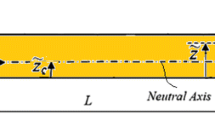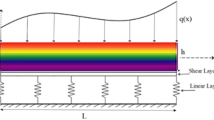Abstract
A size-dependent model for bending and free vibration of functionally graded piezoelectric (FGP) microbeam is developed by using modified couple stress theory and a unified higher order beam theory. This model can be specialized to various beam models, such as Euler–Bernoulli, Timoshenko as well as Reddy beam ones and vice versa. The governing equations of motion and associated boundary conditions are derived from Hamilton’s principle. Only one material length scale parameter is introduced to capture the size effect. The analytical solutions of simply supported FGP microbeam are presented by using Navier approach to bring out the effect of the material length scale parameter on the bending and free vibration of microbeam. Numerical simulations are presented to account for the effect of various parameters, such as material length scale parameters, volume fraction indexes, and slenderness ratios on the responses of static bending and free vibration of FGP microbeam.






Similar content being viewed by others
References
Faris W, Nayfeh AH (2007) Mechanical response of a capacitive microsensor under thermal load. Commun Nonlinear Sci Numer Simul 12:776–783
Najar F, Choura S, El-Borgi S, Abdel-Rahman E, Nayfeh A (2005) Modeling and design of variable-geometry electrostatic microactuators. J Micromech Microeng 15:419
Li X, Bhushan B, Takashima K, Baek C-W, Kim Y-K (2003) Mechanical characterization of micro/nanoscale structures for MEMS/NEMS applications using nanoindentation techniques. Ultramicroscopy 97:481–494
Fleck N, Muller G, Ashby M, Hutchinson J (1994) Strain gradient plasticity: theory and experiment. Acta Metall Mater 42:475–487
Stölken J, Evans A (1998) A microbend test method for measuring the plasticity length scale. Acta Mater 46:5109–5115
McFarland AW, Colton JS (2005) Role of material microstructure in plate stiffness with relevance to microcantilever sensors. J Micromech Microeng 15:1060–1067
Koiter W (1969) Couple-stresses in the theory of elasticity. Dictionary Geotechnical Engineering/wörterbuch Geotechnik 67:1385
Mindlin R, Tiersten H (1962) Effects of couple-stresses in linear elasticity. Arch Rational Mech Anal 11:415–448
Toupin RA (1962) Elastic materials with couple-stresses. Arch Rational Mech Anal 11:385–414
Eringen AC (1972) Nonlocal polar elastic continua. Int J Eng Sci 10:1–16
Lam D, Yang F, Chong A, Wang J, Tong P (2003) Experiments and theory in strain gradient elasticity. J Mech Phys Solids 51:1477–1508
Yang F, Chong A, Lam D, Tong P (2002) Couple stress based strain gradient theory for elasticity. Int J Solids Struct 39:2731–2743
Park S, Gao X (2006) Bernoulli–Euler beam model based on a modified couple stress theory. J Micromech Microeng 16:2355
Kong S, Zhou S, Nie Z, Wang K (2008) The size-dependent natural frequency of Bernoulli–Euler micro-beams. Int J Eng Sci 46:427–437
Kahrobaiyan M, Asghari M, Rahaeifard M, Ahmadian M (2010) Investigation of the size-dependent dynamic characteristics of atomic force microscope microcantilevers based on the modified couple stress theory. Int J Eng Sci 48:1985–1994
Ma H, Gao X, Reddy J (2008) A microstructure-dependent Timoshenko beam model based on a modified couple stress theory. J Mech Phys Solids 56:3379–3391
Ke L-L, Wang Y-S (2011) Flow-induced vibration and instability of embedded double-walled carbon nanotubes based on a modified couple stress theory. Physica E Low Dimens Syst Nanostruct 43:1031–1039
Fu Y, Zhang J (2010) Modeling and analysis of microtubules based on a modified couple stress theory. Physica E Low Dimens Syst Nanostruct 42:1741–1745
Ma H, Gao X-L, Reddy J (2010) A nonclassical Reddy–Levinson beam model based on a modified couple stress theory. Int J Multiscale Comput Eng 8:167–180
Akgoz B, Civalek O (2011) Strain gradient elasticity and modified couple stress models for buckling analysis of axially loaded micro-scaled beams. Int J Eng Sci 49:1268–1280
Xia W, Wang L, Yin L (2010) Nonlinear non-classical microscale beams: static bending, postbuckling and free vibration. Int J Eng Sci 48:2044–2053
Asghari M, Kahrobaiyan MH, Ahmadian MT (2010) A nonlinear Timoshenko beam formulation based on the modified couple stress theory. Int J Eng Sci 48:1749–1761
Ma HM, Gao XL, Reddy JN (2011) A non-classical Mindlin plate model based on a modified couple stress theory. Acta Mech 220:217–235
Kim J, Reddy JN (2013) Analytical solutions for bending, vibration, and buckling of FGM plates using a couple stress-based third-order theory. Compos Struct 103:86–98
Reddy JN, Kim J (2012) A nonlinear modified couple stress-based third-order theory of functionally graded plates. Compos Struct 94:1128–1143
Şimşek M, Reddy JN (2013) A unified higher order beam theory for buckling of a functionally graded microbeam embedded in elastic medium using modified couple stress theory. Compos Struct 101:47–58
Şimşek M, Reddy JN (2013) Bending and vibration of functionally graded microbeams using a new higher order beam theory and the modified couple stress theory. Int J Eng Sci 64:37–53
Lee JS, Jiang LZ (1996) Exact electroelastic analysis of piezoelectric laminae via state space approach. Int J Solids Struct 33:977–990
Heyliger P (1997) Exact solutions for simply supported laminated piezoelectric plates. J Appl Mech 64:299–306
Lee H-J (2005) Layerwise laminate analysis of functionally graded piezoelectric bimorph beams. J Intel Mater Syst Struct 16:365–371
Zhu X, Meng Z (1995) Operational principle, fabrication and displacement characteristics of a functionally gradient piezoelectric ceramic actuator. Sens Actuators A 48:169–176
Wu C, Kahn M, Moy W (1996) Piezoelectric ceramics with functional gradients: a new application in material design. J Am Ceram Soc 79:809–812
Kruusing A (2000) Analysis and optimization of loaded cantilever beam microactuators. Smart Mater Struct 9:186
Yang J, Xiang H (2007) Thermo-electro-mechanical characteristics of functionally graded piezoelectric actuators. Smart Mater Struct 16:784
Doroushi A, Eslami M, Komeili A (2011) Vibration analysis and transient response of an FGPM beam under thermo-electro-mechanical loads using higher-order shear deformation theory. J Intel Mater Syst Struct 22:231–243
Reddy J (2011) Microstructure-dependent couple stress theories of functionally graded beams. J Mech Phys Solids 59:2382–2399
Arash B, Wang Q (2012) A review on the application of nonlocal elastic models in modeling of carbon nanotubes and graphenes. Comput Mater Sci 51:303–313
Anjomshoa A, Shahidi AR, Hassani B, Jomehzadeh E (2014) Finite element buckling analysis of multi-layered graphene sheets on elastic substrate based on nonlocal elasticity theory. Appl Math Modell 38:5934–5955
Akgöz B, Civalek Ö (2012) Free vibration analysis for single-layered graphene sheets in an elastic matrix via modified couple stress theory. Mater Design 42:164–171
Mohammadimehr M, Mohandes M (2015) The effect of modified couple stress theory on buckling and vibration analysis of functionally graded double-layer boron nitride piezoelectric plate based on CPT. J Solid Mech 7:281–298
Komijani M, Reddy JN, Ferreira AJM (2014) Nonlinear stability and vibration of pre/post-buckled microstructure-dependent FGPM actuators. Meccanica 49:2729–2745
Li YS, Feng WJ, Cai ZY (2014) Bending and free vibration of functionally graded piezoelectric beam based on modified strain gradient theory. Compos Struct 115:41–50
Li YS, Pan E (2015) Static bending and free vibration of a functionally graded piezoelectric microplate based on the modified couple-stress theory. Int J Eng Sci 97:40–59
Ebrahimi F, Salari E (2015) Size-dependent thermo-electrical buckling analysis of functionally graded piezoelectric nanobeams. Smart Mater Struct 24:125007
Romano G, Barretta R, Diaco M (2016) Micromorphic continua: non-redundant formulations. Continuum Mech Thermodyn 28:1659–1670
Barbagallo G, Madeo A, d’Agostino MV, Abreu R, Ghiba I-D, Neff P (2017) Transparent anisotropy for the relaxed micromorphic model: macroscopic consistency conditions and long wave length asymptotics. Int J Solids Struct 120:7–30
Neff P, Madeo A, Barbagallo G, D’Agostino MV, Abreu R, Ghiba ID (2017) Real wave propagation in the isotropic-relaxed micromorphic model. Proc Math Phys Eng Sci 473:20160790
Lam DCC, Yang F, Chong ACM, Wang J, Tong P (2003) Experiments and theory in strain gradient elasticity. J Mech Phys Solids 51:1477–1508
Yang F, Chong ACM, Lam DCC, Tong P (2002) Couple stress based strain gradient theory for elasticity. Int J Solids Struct 39:2731–2743
Wanji C, Chen W, Sze KY (2012) A model of composite laminated Reddy beam based on a modified couple-stress theory. Compos Struct 94:2599–2609
Acknowledgements
This research was partially supported by the National Natural Science Foundation of China (Grant no. 11572151), the Priority Academic Program Development of Jiangsu Higher Education Institutions and Qing Lan Project.
Author information
Authors and Affiliations
Corresponding author
Rights and permissions
About this article
Cite this article
Li, Z., Wang, H. & Zheng, S. Bending and free vibration of functionally graded piezoelectric microbeams based on the modified couple stress theory. Ann. Solid Struct. Mech. 10, 1–16 (2018). https://doi.org/10.1007/s12356-017-0050-0
Received:
Accepted:
Published:
Issue Date:
DOI: https://doi.org/10.1007/s12356-017-0050-0




